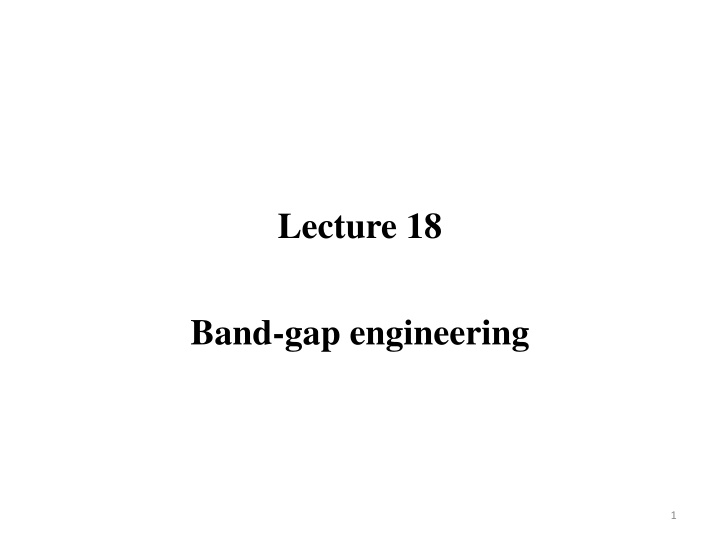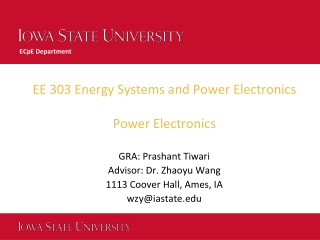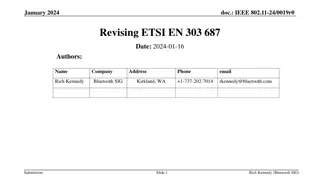
Band-gap Engineering in Semiconductor Technology
Explore the concept of band-gap engineering, where the band gap of semiconductors is manipulated to tailor their properties for specific applications. Learn about techniques such as molecular-beam epitaxy and strain-induced band-gap engineering, and how this innovative approach revolutionizes material design in the field of physics.
Download Presentation

Please find below an Image/Link to download the presentation.
The content on the website is provided AS IS for your information and personal use only. It may not be sold, licensed, or shared on other websites without obtaining consent from the author. If you encounter any issues during the download, it is possible that the publisher has removed the file from their server.
You are allowed to download the files provided on this website for personal or commercial use, subject to the condition that they are used lawfully. All files are the property of their respective owners.
The content on the website is provided AS IS for your information and personal use only. It may not be sold, licensed, or shared on other websites without obtaining consent from the author.
E N D
Presentation Transcript
Lecture 18 Band-gap engineering 1
Recap Magnetoresistance is the tendency of a material (often ferromagnetic) to change the value of its electrical resistance in an externally-applied magnetic field. Vibrations and imperfections cause collisions, increasing the resistance of the crystal. This dependence of resistance on magnetic field is called magnetoresistance. Magnetoresistance is proportional to the strength of the magnetic field, with a larger field producing a higher resistance. 2
Band-gap engineering Band gap engineering, which is the insight that won Herb Kroemer the Nobel Prize in Physics in 2000 , is the idea that we can create novel semiconductors by alloying or mixing existing semiconductors to tailor the band gap of the material. This, in turn, tailors other properties of electrons in the material like their velocity and sensitivity to magnetic field. The Band-gap engineering is the process of controlling or altering the band gap of a material 3
Band-gap engineering This is typically done to semiconductors by controlling the composition of alloys or constructing layered materials with alternating compositions. A band gap is the range in a solid where no electron state can exist. The band gap of insulators is much larger than in semiconductors. Conductors or metals have a much smaller or nonexistent band gap than semiconductors since the valence and conduction bands overlap. Controlling the band gap allows for the creation of desirable electrical properties. 5
Methods 1 Molecular-beam epitaxy (MBE) 2 Strain-induced band-gap engineering 3 Energy band-gap engineering of graphene nanoribbons 6
Molecular-beam epitaxy (MBE) Molecular-beam epitaxy is a technique used to construct thin epitaxial films of materials ranging from oxides to semiconductors to metals. Epitaxy refers to the deposition of an overlayer on a crystalline substrate, where the overlayer is in registry with the substrate. The overlayer is called an epitaxial film or epitaxial layer. Different beams of atoms and molecules in an ultra-high vacuum environment are shot onto a nearly atomically clean crystal, creating a layering effect. 7
Molecular-beam epitaxy (MBE) This is a type of thin-film deposition. Semiconductors are the most commonly used material due to their use in electronics. Technologies such as quantum well devices, super-lattices, and lasers are possible with MBE. Epitaxial films are useful due to their ability to be produced with electrical properties different from those of the substrate, either higher purity, or fewer defects or with a different concentration of electrically active impurities as desired. Varying the composition of the material alters the band gap due to bonding of different atoms with differing energy level gaps. 8
Molecular-beam epitaxy (MBE) We can make an interesting new crystal using MBE, we start off with a base material called a substrate, which could be a familiar semiconductor material such as silicon, germanium, or gallium arsenide. First, we heat the substrate, typically to some hundreds of degrees (for example, 500 600 C or about 900 1100 F in the case of gallium arsenide). Then we fire relatively precise beams of atoms or molecules (heated up so they're in gas form) at the substrate from "guns" called effusion cells. 9
Molecular-beam epitaxy (MBE) We need one "gun" for each different beam, shooting a different kind of molecule at the substrate, depending on the nature of the crystal we're trying to create. The molecules land on the surface of the substrate, condense, and build up very slowly and systematically in ultra-thin layers, so the complex, single crystal grows one atomic layer at a time. That's why MBE is an example of what's called thin-film deposition. Since it involves building up materials by manipulating atoms and molecules, it's also a perfect example of what we mean by nanotechnology. 10
Molecular-beam epitaxy (MBE) One reason that MBE is such a precise way of making a crystal is that it happens in highly controlled conditions: extreme cleanliness and what's called an ultra-high vacuum (UHV), so no dirt particles or unwanted gas molecules can interfere with or contaminate the crystal growth. "Extreme cleanliness" means even cleaner than the conditions used in normal semiconductor manufacture; an "ultra-high vacuum" means the pressure is so low that it's at the limit of what's easily measurable. 11
Examples The simplest example of band gap engineering is the case of two compound semiconductors, gallium arsenide, GaAs, and aluminum arsenide, AlAs. They can be combined at the crystal growth stage to form the alloy semiconductor AlGaAs. For this to remain a semiconductor crystal, the sum of Al plus Ga atoms in the solid must exactly match the number of arsenic, As, atoms in the solid. If we start by growing GaAs in a Molecular Beam Epitaxy (MBE) system and abruptly change the amount of Al depositing on the wafer from zero to some rate comparable to the rate of Ga deposition while decreasing the amount of Ga, we will form Al1 xGaxAs. 12
Examples Where the x represents the fraction of Ga in the AlGaAs material. When doing this, we can maintain the crystal order of the semiconductor and form a boundary, an interface, that is atomically abrupt between the two materials. GaAs has a band gap Eg=1.42eV while AlAs has a band gap of Eg=2.2. By choosing the fraction, x, carefully, we can grow a semiconductor with a band gap anywhere between these two limits. Choosing x is the engineering part. 13
Summary The Band-gap engineering is the process of controlling or altering the band gap of a material. This is typically done to semiconductors by controlling the composition of alloys or constructing layered materials with alternating compositions. Controlling the band gap allows for the creation of desirable electrical properties. Molecular-beam epitaxy is a technique used to construct thin epitaxial films of materials ranging from oxides to semiconductors to metals. Varying the composition of the material alters the band gap due to bonding of different atoms with differing energy level gaps. 14






















